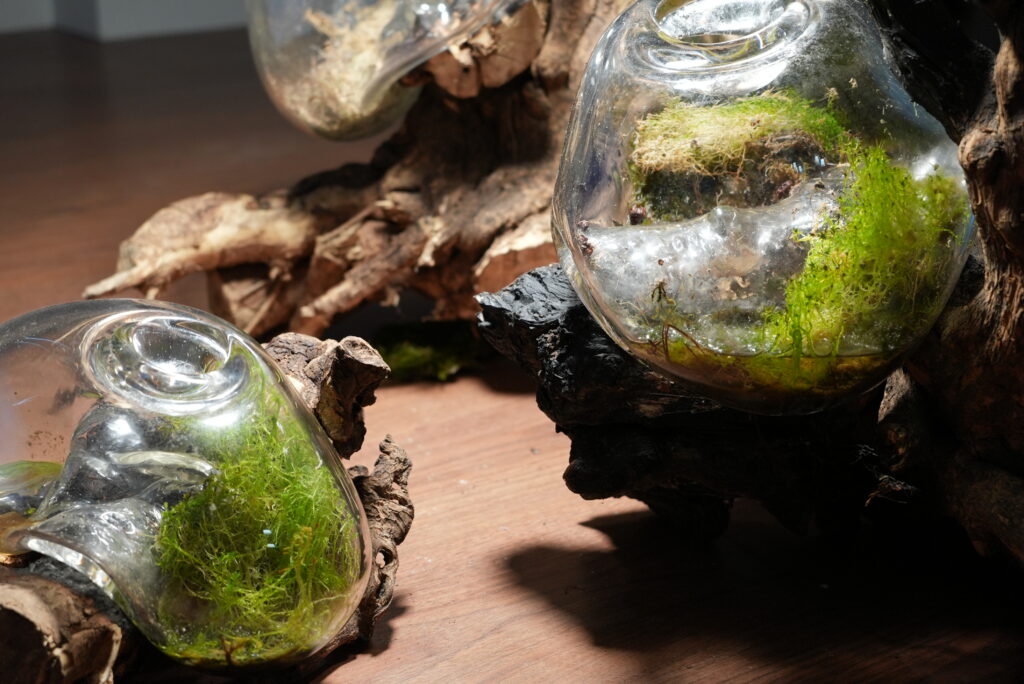
Curated by Tristan Sauer
Featuring works by Maria Simmons, Patrick Stochmal, Sherri Hay and Tasman Richardson
April 5th-May 3rd
Humanity has long been in conflict with itself for the control, commodification, and plundering of resources. Yet, the one most precious to us is also often the most intangible. Time, the seemingly infinite yet undeniably finite resource we all hold and must manage. Our understanding of time as finite is baked right into how we speak about it. Time is wasted, spent, lost, and killed. We understand at a fundamental level that time is always passing, it’s a core piece of knowledge that drives us to persist, desire, and live. Yet, as sacred a level that we hold time, it is an extremely ephemeral and intangible resource. We cannot mine it, or create more of it, we can only preserve it and watch it move by. The artists in this exhibition have employed time in their work as not just a basis for their mediums, but as the medium itself. They explore time as uncontrollable, a medium that creates, destroys, and simply exists as a part of our lives, world, and understanding of both. With every attempt to capture, respect and understand time, the artists explore unique experiences of the concept of time and how it shapes our very understanding of human existence.
Maria Simmons: In Anoxic Memory, overturned tree roots become home to glass bubbles akin to the methane gases that escape them. The methane gases have been the instigators of many myths. The glass bubbles house miniature living peat bogs, constructed from salvaged mass, that are sustained within closed environments. Peat bogs possess anaerobic abilities and the natural chemical acidity to create perfect environments for preservation. Ancient bodies that have fallen into bogs have been preserved like fruit in jars, retaining their features, skin, and even poses. Simmons explores peat bogs as areas of preservation, framing them as one of the few naturally forming time capsules. Simmons captures fragments of a living bog and uses these forms to explore the deep mythologies surrounding peat bogs as sites of ritual and historical preservation. The methane bubbles draw attention to specific mythologies of ancient storages of greenhouse gases escaping from bogs as they are disturbed and naturally release these elements. Anoxic Memory explores the passage of time not through its transformative abilities, but through its preservation. Peat bogs stand in opposition to the expected decay and regrowth of biological material over the course of time, creating areas of stasis outside of what we are used to from the natural world. It ponders how memories can be contained in physical forms, and how sites that defy or resist the naturally destructive transformations of time become reflections of our own pasts and sites of great mythological and spiritual importance.
Parick Stochmal: Riverbed (reconciling separability) is a durational performance captured in digital video. Patrick Stochmal documents the burying of himself within a riverbed for an hour, breathing via the assistance of an oxygen tank. Stones taken from the river holding him down. The video is a moment in waiting, the river flows, and we the viewers wait in anticipation, as does the artist under the currents. Stochmal explores the ephemerality of time, placing himself in a state where he is present yet all human intervention is removed. He remains unchanged as the river ebbs and flows around him, charting its own paths, uncaring of his presence. The performance is a prolonged wait of tension and anticipation. The same the artist feels as he waits out his time beneath the surface that flows despite how he lays in it and for how long he chooses to. When the video cuts and Stochmal emerges the river will continue.
Sherri Hay: The spell cast here is a kinetic sculpture which evolves over the period of 5 hours as the ice in it melts. The spell cast here focuses on movement, time, relationships and change. Hay explores the shifting temporalities and epistemologies in objects that disclose something akin to personality. By focusing attention on materials that are usually ignored and moving things that don’t normally move, the work explores the way we think of our fellow beings in this world. For the whole work to complete its chronological cycle time must be applied. Starting and ending at different resting positions.
Tasman Richardson: Through the use of an immersive VR and elements taken from Dutch vanitas painting Tasman Richardson contrasts the past and present against each other while asking viewers to consider the imprint of time on everything in the room. I am aging in a room (The Harvest) explores time in an extremely tactile manner. Viewers observe a compressed version of the contexts, changes, and aftermaths of the location they are viewing, and currently sitting in. Time is etched into the very table, chair, and flowers they find themselves in front of, both before and after they take off the headset. The juxtaposition between these two moments, viscerally changes the viewer’s perception of their current environment as they become immediately aware of the passage of time. No answers are provided as to how this passage is meant to be perceived, simply that it has happened and will continue to happen, in this space and all spaces.




